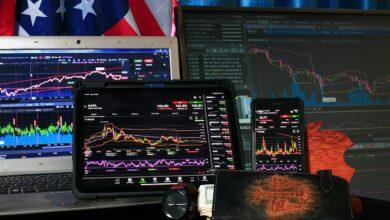Guarding Your Crypto – Insider Threats Uncovered

In the rapidly evolving landscape of cryptocurrency, where innovation and speculation intertwine, the allure of trading platforms offers both immense opportunity and inherent risk. While many focus on external threats such as hacking or market volatility, it is crucial not to overlook the internal dangers lurking within these exchanges. Insider threats can manifest in various forms, from the exploitation of privileged information to deliberate malfeasance by employees or contractors. Safeguarding yourself against these internal risks requires a deep understanding of the mechanisms at play and a proactive approach to defending your assets.
As we navigate this intricate web of digital finance, it becomes evident that shielding yourself against insider threats is not merely a matter of compliance or regulatory oversight; it is an essential aspect of responsible trading. The integrity of cryptocurrency exchanges hinges on trust, yet this trust can be easily undermined by individuals with access to sensitive data and systems. Thus, protecting oneself involves not only scrutinizing the security measures of the platforms we engage with but also fostering a culture of transparency and accountability within these organizations.
In this article, we will explore the multifaceted nature of insider threats in crypto trading platforms and outline strategies for effectively mitigating these risks. By understanding the potential vulnerabilities inherent in internal operations and employing practical safeguards, traders can fortify their positions against both intentional misconduct and inadvertent negligence. Ultimately, safeguarding your investments in this dynamic environment requires vigilance, education, and a commitment to ethical practices–elements that are paramount for anyone serious about engaging with cryptocurrencies.
Understanding Insider Threats in Crypto Trading Platforms
In the rapidly evolving world of cryptocurrency, insider threats present a significant risk that often goes unnoticed until it’s too late. These threats arise from individuals within the organization–employees, contractors, or business partners–who have access to sensitive information and systems. In a crypto trading platform, such insiders may exploit their access to manipulate prices, execute trades for personal gain, or leak confidential data. Protecting yourself against these internal risks is paramount for maintaining a secure trading environment and confidence in the integrity of the market.
Defending against insider threats requires a multifaceted approach that includes both technological and procedural safeguards. Implementing robust access controls is crucial; this means ensuring that employees have access only to the information necessary for their roles. Regular audits of access logs can reveal unusual patterns of behavior that may indicate an insider threat. Moreover, employing advanced monitoring tools can help detect anomalies in trading patterns or system usage, providing an early warning system against potential abuses.
Shielding your investments from internal dangers also involves fostering a culture of transparency and accountability within the organization. Regular training sessions on ethical conduct and the implications of insider trading can cultivate an awareness of the risks involved. Encouraging open communication about concerns regarding unethical behaviors can empower employees to report suspicious activities without fear of reprisal. This proactive stance can deter potential threats before they escalate into harmful actions.
Additionally, safeguarding against internal risks extends to the selection of crypto exchanges themselves. Not all platforms implement stringent security measures; therefore, choosing reputable exchanges is vital. Look for platforms that prioritize security protocols such as two-factor authentication, encrypted communications, and regular security audits. Researching user reviews and incident histories can provide insights into how well an exchange has managed previous threats and whether it has taken adequate steps to improve its defenses.
Incorporating technological solutions such as blockchain analytics can further enhance your defense strategy. These tools analyze transaction patterns to identify irregularities that could signify insider misconduct. By understanding these analytical frameworks, traders can better protect themselves by recognizing potential red flags in their transactions or those occurring on the platform they are using. As the industry matures, utilizing such technologies will become increasingly essential in safeguarding assets from internal vulnerabilities.
Ultimately, protecting yourself from insider threats in cryptocurrency trading involves a blend of vigilance, education, and technology. As these risks continue to evolve alongside the crypto landscape, maintaining an adaptive and informed approach will be key to mitigating potential damages. By understanding the nature of insider threats and implementing comprehensive defensive strategies, traders can ensure a more secure and trustworthy trading environment within this dynamic field.
Common Types of Insider Threats in Crypto Trading Platforms
In the rapidly evolving world of cryptocurrency, insider threats have emerged as a significant concern for traders and investors alike. These threats originate from individuals within an organization–employees, contractors, or business partners–who exploit their access to systems and data for malicious purposes. Common types include unauthorized trading, data theft, and the manipulation of market prices. Such actions can lead to substantial financial losses and erode trust in crypto trading platforms, making it imperative for users to understand these risks.
Defending yourself from insider threats in crypto trading requires a multifaceted approach. First and foremost, awareness is vital; users should be educated about the potential risks associated with internal actors. Implementing robust security protocols, such as two-factor authentication (2FA) and regular audits of trading activities, can significantly reduce vulnerabilities. Additionally, fostering a culture of transparency within organizations can deter potential malicious actions by employees who know they are being monitored.
Safeguarding against internal risks in cryptocurrency exchanges involves adopting best practices in cybersecurity. Regular training sessions on security measures and ethical behavior should be conducted for all employees. Moreover, exchanges should enforce strict access controls, granting permissions based on the principle of least privilege. This limits the potential for misuse of sensitive information or trading capabilities by restricting access only to those who genuinely require it.
Another crucial element in shielding against internal threats on crypto platforms is the implementation of thorough background checks during the hiring process. By vetting employees carefully, organizations can weed out individuals with questionable histories that could pose risks to the integrity of the platform. Furthermore, continuous monitoring of employee activities using advanced analytics tools can help identify unusual patterns indicative of insider threats before they escalate into more serious issues.
In addition to preventive measures, having a robust incident response strategy is essential for minimizing damage when an insider threat is detected. This includes having clear protocols in place for reporting suspicious behavior and addressing breaches swiftly. Organizations should also consider engaging external cybersecurity experts to conduct penetration testing and vulnerability assessments regularly, ensuring that their defenses remain strong against evolving threats.
Ultimately, protecting yourself in the crypto trading realm requires vigilance and proactive measures against insider threats. By understanding common types of risks and implementing comprehensive safeguarding strategies–ranging from employee education to stringent access controls–traders can navigate the complex landscape of cryptocurrency exchanges with greater confidence. The goal is not just to survive potential threats but to cultivate an environment where security is ingrained in the very fabric of trading operations.
Best Practices for Security: Safeguarding Against Internal Risks in Cryptocurrency Exchanges
In the rapidly evolving world of cryptocurrency trading, the necessity of protecting oneself against insider threats has never been more pressing. Insider threats can manifest in various forms, from data breaches to fraudulent transactions, often originating from individuals who have privileged access to sensitive information. This makes it essential for crypto exchanges to implement robust security measures that not only safeguard their platforms but also defend users from internal risks. Understanding these threats and employing best practices is key to a secure trading environment.
First and foremost, transparency is crucial in shielding against internal threats. Exchanges should establish clear protocols for monitoring user activity and access logs, ensuring that any unusual behavior is promptly investigated. Regular audits and compliance checks can help identify potential vulnerabilities within the system. Furthermore, adopting a culture of accountability among employees fosters an environment where unethical behavior is less likely to occur. By actively promoting ethical standards and providing training on recognizing insider threats, organizations can empower their staff to protect themselves and the platform.
Another effective method of safeguarding against insider risks involves implementing multi-factor authentication (MFA) and strict access controls. MFA adds an additional layer of security by requiring multiple forms of verification before granting access to sensitive areas of the exchange. This approach significantly reduces the likelihood of unauthorized access, even if an insider’s credentials are compromised. Similarly, limiting access rights based on job function ensures that employees only have the permissions necessary for their roles, thereby minimizing the risk of malicious actions from within.
Lastly, fostering open communication between management and employees is vital in defending against insider threats on crypto trading platforms. Encouraging whistleblowing policies allows team members to report suspicious activities without fear of retribution, creating a more vigilant organizational culture. By staying aware of potential red flags–such as sudden changes in employee behavior or significant discrepancies in trading patterns–exchanges can proactively address internal risks before they escalate into larger issues. Ultimately, a comprehensive approach that combines technology, policy, and culture will serve as a powerful defense against the persistent threat posed by insiders in the cryptocurrency space.
Tools to Mitigate Risks; Shielding Against Internal Threats on Crypto Platforms
In the rapidly evolving landscape of cryptocurrency trading, mitigating risks associated with insider threats has become paramount. The very nature of decentralized finance and the anonymity it affords can often obscure malicious activities from internal actors–employees who have access to sensitive information and systems. Therefore, safeguarding against these internal risks is not a mere option but an essential practice for any trading platform seeking longevity and trustworthiness.
One of the most effective tools in protecting yourself from insider threats is robust access control mechanisms. By implementing strict role-based access controls (RBAC), platforms can ensure that employees only have access to information necessary for their specific roles. This minimizes the risk of insider manipulation or data breaches. Furthermore, regular audits of access logs can help in promptly identifying any unauthorized attempts to access sensitive areas of the system, reinforcing a culture of accountability and vigilance.
In addition to access controls, employing advanced monitoring systems is vital for defending against potential insider threats. Real-time analytics can track user behavior patterns, flagging any anomalies that deviate from established norms. For instance, if an employee suddenly accesses large volumes of data they typically do not handle or attempts to transfer significant assets without prior authorization, such actions can trigger alerts for further investigation. This proactive approach allows platforms to act swiftly before potential damage escalates.
Training and awareness programs are also crucial tools in the arsenal against internal risks within cryptocurrency exchanges. Regularly educating staff about the implications of insider threats and the importance of ethical behavior fosters a culture of responsibility among employees. Workshops and simulations can provide real-world scenarios that prepare staff to recognize and report suspicious activity. By equipping employees with knowledge, organizations bolster their defenses against internal malfeasance.
Moreover, implementing a whistleblower policy encourages a transparent environment where employees feel safe reporting suspicious behaviors without fear of retribution. Such policies not only protect individuals but also serve as a deterrent against potential insider misconduct. When employees understand that their concerns will be taken seriously, it creates an atmosphere conducive to vigilance and mutual protection.
Finally, leveraging technology such as blockchain for audit trails can enhance transparency within crypto trading platforms. Immutable records provide an additional layer of security by allowing all transactions and changes to be tracked and verified independently. In this way, organizations can demonstrate their commitment to safeguarding against insider threats while maintaining trust among users–essential for long-term success in the volatile world of cryptocurrency trading.
Legal Protections for Traders in the Crypto Landscape
In the rapidly evolving world of cryptocurrency, trading platforms serve as both gateways to opportunity and potential arenas for risk. The dual nature of these exchanges is undeniable; they are hubs of innovation, yet they can also harbor internal threats that challenge the very essence of trust. As we delve deeper into the nuances of protecting yourself against insider threats, it’s imperative to recognize that safeguarding your investments and personal information is not just a matter of caution–it’s an essential strategy for success.
The landscape of legal protections available to traders is as varied as the cryptocurrencies themselves. From regulatory frameworks designed to enhance transparency on trading platforms to specific measures that help defend against internal risks, understanding these tools equips you with a robust arsenal. In this context, the responsibility for protecting oneself must extend beyond mere vigilance; it requires a proactive stance that embraces both awareness and action.
Conclusion: A Multifaceted Approach to Defending Against Insider Threats
As we conclude our exploration of how to shield against internal threats in cryptocurrency exchanges, several key principles emerge that can guide traders in this intricate domain:
- Awareness: Always remain informed about the potential risks inherent in trading platforms. Understanding how insider threats manifest allows you to identify red flags more readily.
- Due Diligence: Conduct thorough research on exchanges before engaging with them. Verify their security protocols and compliance with legal standards to ensure you’re operating within a safe environment.
- Active Participation: Engage with community forums and stay connected with other traders. Sharing experiences and insights can provide valuable information that helps fortify your defenses against internal threats.
- Utilize Legal Protections: Familiarize yourself with the legal frameworks surrounding cryptocurrency trading. Knowing your rights and protections can empower you, should any issues arise within a platform.
Ultimately, defending yourself from insider threats in the world of crypto trading is a dynamic endeavor. It encompasses not only understanding the mechanisms at play but also cultivating a mindset geared towards resilience. By actively protecting yourself against these internal risks, you not only safeguard your assets but also contribute to fostering a healthier ecosystem for all participants in this revolutionary marketplace. Remember, in the intricate dance of cryptocurrency trading, knowledge is not just power; it’s your most potent shield against unforeseen challenges.





